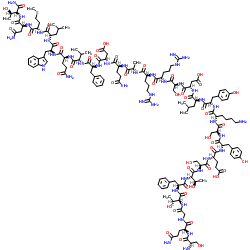Potentiation of glucose-induced insulin release in islets by desHis1[Glu9]glucagon amide.
H Kofod, C G Unson, R B Merrifield
Index: Int. J. Pept. Protein Res. 32(6) , 436-40, (1988)
Full Text: HTML
Abstract
Glucagon and secretin and some of their hybrid analogs potentiate glucose-induced release of insulin from isolated mouse pancreatic islets. It was recently shown that the synthetic glucagon analog, desHis1[Glu9]glucagon amide, does not stimulate the formation of cyclic adenosine monophosphate in the rat hepatocyte membrane, but binds well to the glucagon receptor and is a good competitive antagonist of glucagon. In the present study the effect of this analog on isolated islets was examined. desHis1-[Glu9]glucagon amide at 3 x 10(-7) M, in the presence of 0.01 M D-glucose, increased the release of insulin by 30% and maintained that level for the full 30-min test period. The rate of insulin release returned to the glucose-induced base line after removal of the peptide. The same insulin level was produced by 3 x 10(-9) M glucagon, and at 3 x 10(-7) M glucagon insulin release was enhanced 290% above the glucose base line.
Related Compounds
| Structure | Name/CAS No. | Molecular Formula | Articles |
|---|---|---|---|
 |
(Des-His1,Glu9)-Glucagon (1-29) amide (human, rat, porcine)
CAS:110084-95-2 |
C148H221N41O47S |
|
Glucagon stimulates exocytosis in mouse and rat pancreatic a...
2005-01-01 [Mol. Endocrinol. 19 , 198-212, (2005)] |
|
Glucagon receptors on human islet cells contribute to glucos...
2000-08-01 [Diabetologia 43 , 1012-1019, (2000)] |
|
Biological activities of des-His1[Glu9]glucagon amide, a glu...
1989-01-01 [Peptides 10 , 1171, (1989)] |
|
Evidence for a potential role of glucagon during eye growth ...
2002-01-01 [Vis. Neurosci. 19 , 755-766, (2002)] |
|
Glucagon-like peptide-1 inhibits insulinotropic effects of o...
2012-04-01 [Domest. Anim. Endocrinol. 42(3) , 155-64, (2012)] |